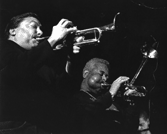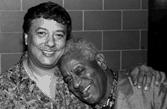But
then...
Previous,
Next
Finally, as bebop became more accepted, Dizzy rose to prominence as one
of its stars. Bebop proponany and producer Leonard
Feather held sessions to assemble the leaders of the 52nd Street scene,
Dizzy's band being a frontrunner. The year had seen the creation
of a successful orchestra, drawing on such talent as vibist Milt Jackson,
bassist Ray Brown, pianist Al
Haig, tenor saxophonist Don
Byas, drummer J.C. Heard, and guitarist Bill De Arango. The resulting
music was sensational: "52nd Street Theme," named this by Feather
for its representation of the scene, featured Byas and Gillespie playing
frenzied choruses based on other pieces and a cycle of fifths..."Night
in Tunisia"also featured Dizzy's double-time runs, bringing boundless energy
to the Gillespie classic..."Anthropology" even featured lines from "We're
In The Money," serving as a reminder of what freedom the music allowed.
After these orchestrations, Dizzy Gillespie stood atop what was a powerful
jazz movement, finally taking its place as the frontrunning jazz style.
 Testament to the power of the music was the ease with which the orchestra
moved past obstacles. Time and Life both ran critical
articles, but Dizzy's band didn't even stumble. In fact, it was still
charting the path for bebop jazz, adding to its lineup tenor saxophonist
James Moody, baritone saxophonist Cecil Payne, and pianist John Lewis.
Fuelled by his rising popularity, Dizzy became increasingly interested
in cultivating Afro-Cuban
music and began to experiment in the area. He turned to his old friend,
Mario Bauza, who in turn introduced him to Chano Pozo. The union
of the two musicians bore "Cubana Be," a duet that constitutes the first
half of "Cubana Be/Cubana Bop," Dizzy's collaboration with George Russell.
He would later work closely with Arturo Sandoval, who he fondly called
"my first son."
Testament to the power of the music was the ease with which the orchestra
moved past obstacles. Time and Life both ran critical
articles, but Dizzy's band didn't even stumble. In fact, it was still
charting the path for bebop jazz, adding to its lineup tenor saxophonist
James Moody, baritone saxophonist Cecil Payne, and pianist John Lewis.
Fuelled by his rising popularity, Dizzy became increasingly interested
in cultivating Afro-Cuban
music and began to experiment in the area. He turned to his old friend,
Mario Bauza, who in turn introduced him to Chano Pozo. The union
of the two musicians bore "Cubana Be," a duet that constitutes the first
half of "Cubana Be/Cubana Bop," Dizzy's collaboration with George Russell.
He would later work closely with Arturo Sandoval, who he fondly called
"my first son."
 Dizzy with Cuban great Arturo Sandoval
Dizzy with Cuban great Arturo Sandoval
Dizzy continued playing for years more, all the while experimenting with
new music styles, and just new things in general. In 1964,
he ran for president of the United States on a platform of Vietnam withdrawal,
desegregation, and a national lottery. In 1977, continuing his interest
in Cuban music, he visited Cuba and had his picture taken with Fidel
Castro. Although this did not make him a favorite around the
State Department, President Jimmy Carter invited him to the White
House. This seemed to end Dizzy's time in the political limelight
and he continued touring, but not as extensively as before.
In 1987, Dizzy played in a band with his protege, Jon Faddis, but made
few appearances after that.
 Dizzy With Arturo Sandoval, 1990
Dizzy With Arturo Sandoval, 1990
Dizzy died of pancreatic cancer in Englewood, New Jersey with his wife
Lorraine in 1993. He is survived by his jazz legacy. He is,
after all, in Ira Gitler's words, a jazz immortal.
This page hosted by  Get your own Free Home Page
Get your own Free Home Page


 Dizzy with Cuban great Arturo Sandoval
Dizzy with Cuban great Arturo Sandoval
